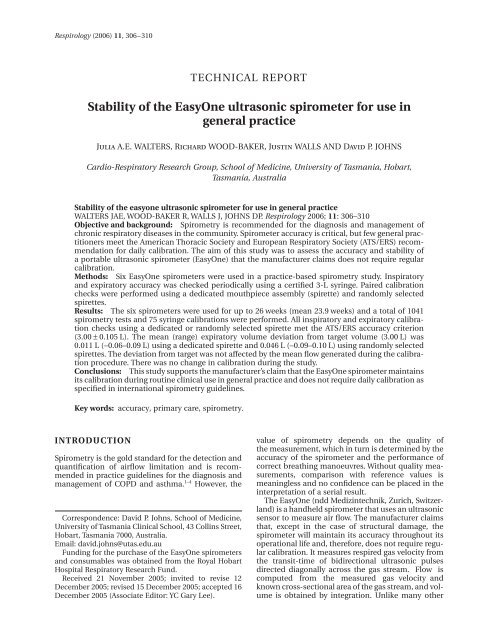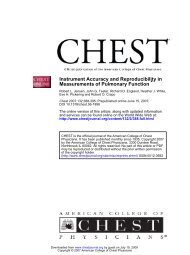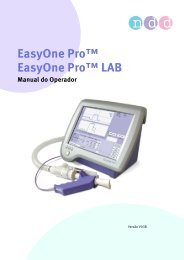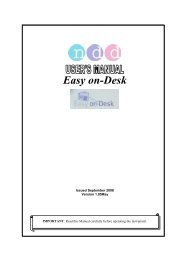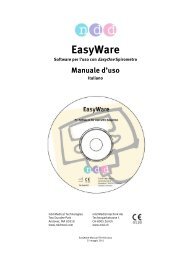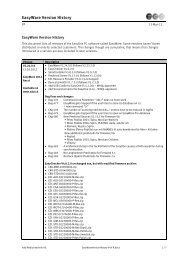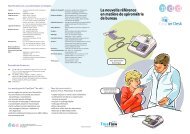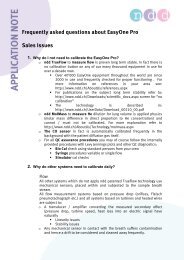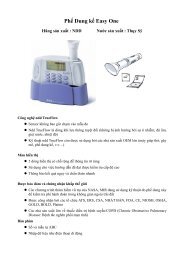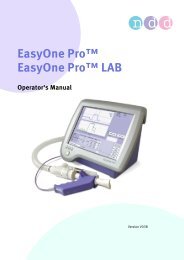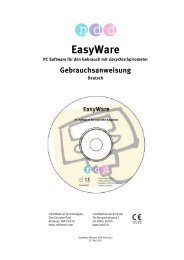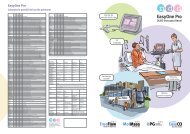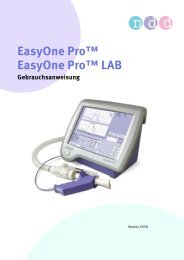Stability of the EasyOne ultrasonic spirometer for use in general ...
Stability of the EasyOne ultrasonic spirometer for use in general ...
Stability of the EasyOne ultrasonic spirometer for use in general ...
You also want an ePaper? Increase the reach of your titles
YUMPU automatically turns print PDFs into web optimized ePapers that Google loves.
Blackwell Publish<strong>in</strong>g AsiaMelbourne, AustraliaRESRespirology1323-77992006 Blackwell Publish<strong>in</strong>g Asia Pty Ltd2006113306310MiscellaneousCalibration <strong>of</strong> an <strong>ultrasonic</strong> <strong>spirometer</strong>JAE Walters<br />
et al.<br />
Respirology (2006) 11, 306–310<br />
Correspondence: David P. Johns, School <strong>of</strong> Medic<strong>in</strong>e,<br />
University <strong>of</strong> Tasmania Cl<strong>in</strong>ical School, 43 Coll<strong>in</strong>s Street,<br />
Hobart, Tasmania 7000, Australia.<br />
Email: david.johns@utas.edu.au<br />
Fund<strong>in</strong>g <strong>for</strong> <strong>the</strong> purchase <strong>of</strong> <strong>the</strong> <strong>EasyOne</strong> <strong>spirometer</strong>s<br />
and consumables was obta<strong>in</strong>ed from <strong>the</strong> Royal Hobart<br />
Hospital Respiratory Research Fund.<br />
Received 21 November 2005; <strong>in</strong>vited to revise 12<br />
December 2005; revised 15 December 2005; accepted 16<br />
December 2005 (Associate Editor: YC Gary Lee).<br />
TECHNICAL REPORT<br />
<strong>Stability</strong> <strong>of</strong> <strong>the</strong> <strong>EasyOne</strong> <strong>ultrasonic</strong> <strong>spirometer</strong> <strong>for</strong> <strong>use</strong> <strong>in</strong><br />
<strong>general</strong> practice<br />
Julia A.E. WALTERS, Richard WOOD-BAKER, Just<strong>in</strong> WALLS AND David P. JOHNS<br />
Cardio-Respiratory Research Group, School <strong>of</strong> Medic<strong>in</strong>e, University <strong>of</strong> Tasmania, Hobart,<br />
Tasmania, Australia<br />
<strong>Stability</strong> <strong>of</strong> <strong>the</strong> easyone <strong>ultrasonic</strong> <strong>spirometer</strong> <strong>for</strong> <strong>use</strong> <strong>in</strong> <strong>general</strong> practice<br />
WALTERS JAE, WOOD-BAKER R, WALLS J, JOHNS DP. Respirology 2006; 11: 306–310<br />
Objective and background: Spirometry is recommended <strong>for</strong> <strong>the</strong> diagnosis and management <strong>of</strong><br />
chronic respiratory diseases <strong>in</strong> <strong>the</strong> community. Spirometer accuracy is critical, but few <strong>general</strong> practitioners<br />
meet <strong>the</strong> American Thoracic Society and European Respiratory Society (ATS/ERS) recommendation<br />
<strong>for</strong> daily calibration. The aim <strong>of</strong> this study was to assess <strong>the</strong> accuracy and stability <strong>of</strong><br />
a portable <strong>ultrasonic</strong> <strong>spirometer</strong> (<strong>EasyOne</strong>) that <strong>the</strong> manufacturer claims does not require regular<br />
calibration.<br />
Methods: Six <strong>EasyOne</strong> <strong>spirometer</strong>s were <strong>use</strong>d <strong>in</strong> a practice-based spirometry study. Inspiratory<br />
and expiratory accuracy was checked periodically us<strong>in</strong>g a certified 3-L syr<strong>in</strong>ge. Paired calibration<br />
checks were per<strong>for</strong>med us<strong>in</strong>g a dedicated mouthpiece assembly (spirette) and randomly selected<br />
spirettes.<br />
Results: The six <strong>spirometer</strong>s were <strong>use</strong>d <strong>for</strong> up to 26 weeks (mean 23.9 weeks) and a total <strong>of</strong> 1041<br />
spirometry tests and 75 syr<strong>in</strong>ge calibrations were per<strong>for</strong>med. All <strong>in</strong>spiratory and expiratory calibration<br />
checks us<strong>in</strong>g a dedicated or randomly selected spirette met <strong>the</strong> ATS/ERS accuracy criterion<br />
(3.00 ± 0.105 L). The mean (range) expiratory volume deviation from target volume (3.00 L) was<br />
0.011 L (−0.06–0.09 L) us<strong>in</strong>g a dedicated spirette and 0.046 L (−0.09–0.10 L) us<strong>in</strong>g randomly selected<br />
spirettes. The deviation from target was not affected by <strong>the</strong> mean flow generated dur<strong>in</strong>g <strong>the</strong> calibration<br />
procedure. There was no change <strong>in</strong> calibration dur<strong>in</strong>g <strong>the</strong> study.<br />
Conclusions: This study supports <strong>the</strong> manufacturer’s claim that <strong>the</strong> <strong>EasyOne</strong> <strong>spirometer</strong> ma<strong>in</strong>ta<strong>in</strong>s<br />
its calibration dur<strong>in</strong>g rout<strong>in</strong>e cl<strong>in</strong>ical <strong>use</strong> <strong>in</strong> <strong>general</strong> practice and does not require daily calibration as<br />
specified <strong>in</strong> <strong>in</strong>ternational spirometry guidel<strong>in</strong>es.<br />
Key words: accuracy, primary care, spirometry.<br />
INTRODUCTION<br />
Spirometry is <strong>the</strong> gold standard <strong>for</strong> <strong>the</strong> detection and<br />
quantification <strong>of</strong> airflow limitation and is recommended<br />
<strong>in</strong> practice guidel<strong>in</strong>es <strong>for</strong> <strong>the</strong> diagnosis and<br />
management <strong>of</strong> COPD and asthma. 1–4 However, <strong>the</strong><br />
value <strong>of</strong> spirometry depends on <strong>the</strong> quality <strong>of</strong><br />
<strong>the</strong> measurement, which <strong>in</strong> turn is determ<strong>in</strong>ed by <strong>the</strong><br />
accuracy <strong>of</strong> <strong>the</strong> <strong>spirometer</strong> and <strong>the</strong> per<strong>for</strong>mance <strong>of</strong><br />
correct breath<strong>in</strong>g manoeuvres. Without quality measurements,<br />
comparison with reference values is<br />
mean<strong>in</strong>gless and no confidence can be placed <strong>in</strong> <strong>the</strong><br />
<strong>in</strong>terpretation <strong>of</strong> a serial result.<br />
The <strong>EasyOne</strong> (ndd Mediz<strong>in</strong>technik, Zurich, Switzerland)<br />
is a handheld <strong>spirometer</strong> that <strong>use</strong>s an <strong>ultrasonic</strong><br />
sensor to measure air flow. The manufacturer claims<br />
that, except <strong>in</strong> <strong>the</strong> case <strong>of</strong> structural damage, <strong>the</strong><br />
<strong>spirometer</strong> will ma<strong>in</strong>ta<strong>in</strong> its accuracy throughout its<br />
operational life and, <strong>the</strong>re<strong>for</strong>e, does not require regular<br />
calibration. It measures respired gas velocity from<br />
<strong>the</strong> transit-time <strong>of</strong> bidirectional <strong>ultrasonic</strong> pulses<br />
directed diagonally across <strong>the</strong> gas stream. Flow is<br />
computed from <strong>the</strong> measured gas velocity and<br />
known cross-sectional area <strong>of</strong> <strong>the</strong> gas stream, and volume<br />
is obta<strong>in</strong>ed by <strong>in</strong>tegration. Unlike many o<strong>the</strong>r
Calibration <strong>of</strong> an <strong>ultrasonic</strong> <strong>spirometer</strong> 307<br />
types <strong>of</strong> <strong>spirometer</strong>, <strong>the</strong> <strong>EasyOne</strong> has no mov<strong>in</strong>g<br />
parts, <strong>the</strong>re<strong>for</strong>e accuracy is not dependent on<br />
mechanical function, nor is it dependent on <strong>the</strong> measurement<br />
<strong>of</strong> variables such as pressure or displacement<br />
volume. Provid<strong>in</strong>g <strong>the</strong> cross-sectional area <strong>of</strong><br />
<strong>the</strong> gas stream is fixed, <strong>the</strong> only variable requir<strong>in</strong>g<br />
accurate measurement is <strong>the</strong> transit-time <strong>of</strong> <strong>the</strong> <strong>ultrasonic</strong><br />
pulses between <strong>the</strong> two transmitters to receivers.<br />
The potential stability <strong>of</strong> <strong>the</strong> calibration was one<br />
reason why this <strong>spirometer</strong> was selected <strong>for</strong> <strong>use</strong> <strong>in</strong><br />
an <strong>in</strong>ternational multicentre study (<strong>the</strong> burden <strong>of</strong><br />
obstructive lung disease <strong>in</strong>itiative (BOLD)) to determ<strong>in</strong>e<br />
<strong>the</strong> prevalence and economic burden <strong>of</strong> COPD. 5<br />
Recently updated <strong>in</strong>ternational guidel<strong>in</strong>es have<br />
confirmed <strong>the</strong> view that <strong>the</strong> accuracy <strong>of</strong> diagnostic<br />
<strong>spirometer</strong>s must be checked at least daily 6 us<strong>in</strong>g a<br />
syr<strong>in</strong>ge with a volume <strong>of</strong> at least 3 L. Dur<strong>in</strong>g a recently<br />
conducted survey <strong>the</strong> authors <strong>of</strong> <strong>the</strong> present study<br />
found that although 64% <strong>of</strong> <strong>general</strong> practices <strong>in</strong><br />
Australia owned a <strong>spirometer</strong>, only 22% <strong>of</strong> <strong>the</strong>se <strong>use</strong> a<br />
calibration syr<strong>in</strong>ge to check <strong>the</strong> accuracy <strong>of</strong> <strong>the</strong>ir<br />
<strong>spirometer</strong>, and only 1.5% actually per<strong>for</strong>m this on<br />
a daily basis. 7 This has <strong>the</strong> potential to reduce <strong>the</strong><br />
cl<strong>in</strong>ical value <strong>of</strong> spirometry measurements unless<br />
<strong>spirometer</strong>s <strong>use</strong>d <strong>in</strong> <strong>general</strong> practice are known to<br />
ma<strong>in</strong>ta<strong>in</strong> <strong>the</strong>ir accuracy. Although <strong>the</strong> manufacturer<br />
claims that <strong>the</strong> <strong>EasyOne</strong> ma<strong>in</strong>ta<strong>in</strong>s its calibration,<br />
<strong>the</strong>re is no published data to support this <strong>in</strong> a cl<strong>in</strong>ical<br />
sett<strong>in</strong>g.<br />
The aim <strong>of</strong> this study was to assess <strong>the</strong> accuracy and<br />
stability <strong>of</strong> <strong>the</strong> <strong>EasyOne</strong> <strong>spirometer</strong> us<strong>in</strong>g a certified<br />
3-L syr<strong>in</strong>ge <strong>in</strong> a <strong>general</strong> practice sett<strong>in</strong>g.<br />
METHODS<br />
Six <strong>EasyOne</strong> <strong>spirometer</strong>s were <strong>use</strong>d <strong>in</strong> a study compar<strong>in</strong>g<br />
models <strong>of</strong> spirometry provision <strong>in</strong> primary<br />
care. Four <strong>spirometer</strong>s were assigned to a specific<br />
<strong>general</strong> practice and two were <strong>use</strong>d by tra<strong>in</strong>ed nurses<br />
at regular spirometry sessions at four o<strong>the</strong>r practices<br />
<strong>in</strong> Sou<strong>the</strong>rn Tasmania. The tra<strong>in</strong>ed nurses carried out<br />
calibration checks periodically accord<strong>in</strong>g to cl<strong>in</strong>ical<br />
usage.<br />
Calibration checks were carried out us<strong>in</strong>g a calibration<br />
syr<strong>in</strong>ge (Hans Rudolph, Kansas, MI, USA) with a<br />
certified accuracy <strong>of</strong> ±0.5% to deliver 3 L <strong>of</strong> room air<br />
through <strong>the</strong> <strong>spirometer</strong> (expiratory calibration check)<br />
<strong>the</strong>n withdrawn back <strong>in</strong>to <strong>the</strong> syr<strong>in</strong>ge (<strong>in</strong>spiratory calibration<br />
check). Operators were <strong>in</strong>structed to empty,<br />
<strong>the</strong>n fill <strong>the</strong> syr<strong>in</strong>ge with<strong>in</strong> 6 s. The volumes measured<br />
by <strong>the</strong> <strong>spirometer</strong> and mean flow dur<strong>in</strong>g <strong>the</strong> calibrations<br />
were recorded. To meet <strong>the</strong> accuracy requirements<br />
<strong>the</strong> volume recorded by <strong>the</strong> <strong>spirometer</strong> us<strong>in</strong>g a<br />
3-L syr<strong>in</strong>ge should be with<strong>in</strong> <strong>the</strong> range 2.895–3.105 L. 6<br />
The <strong>spirometer</strong> <strong>use</strong>s a disposable mouthpiece<br />
assembly (spirette) consist<strong>in</strong>g <strong>of</strong> a biodegradable<br />
polyethylene tube <strong>in</strong>serted <strong>in</strong>to <strong>the</strong> device and<br />
through which <strong>the</strong> subject per<strong>for</strong>ms <strong>the</strong> spirometry<br />
test and <strong>the</strong> operator per<strong>for</strong>ms <strong>the</strong> calibration check.<br />
For each <strong>spirometer</strong>, paired syr<strong>in</strong>ge calibrations were<br />
per<strong>for</strong>med us<strong>in</strong>g a s<strong>in</strong>gle dedicated spirette reserved<br />
<strong>for</strong> calibration and a new spirette randomly selected<br />
on each occasion.<br />
STATISTICS<br />
For each device <strong>the</strong> mean and SD <strong>of</strong> expiratory and<br />
<strong>in</strong>spiratory volumes (L) and flows (L/s) were calculated<br />
<strong>for</strong> both <strong>the</strong> dedicated and random spirettes.<br />
Differences between measured and 3.00 L target<br />
volume were plotted aga<strong>in</strong>st time <strong>of</strong> <strong>spirometer</strong> <strong>use</strong><br />
and flow. Paired calibrations with dedicated and new<br />
spirettes were compared us<strong>in</strong>g <strong>the</strong> method <strong>of</strong> Bland<br />
and Altman. 8<br />
RESULTS<br />
The six <strong>EasyOne</strong> <strong>spirometer</strong>s were <strong>use</strong>d <strong>in</strong> cl<strong>in</strong>ical<br />
practice <strong>for</strong> between 15.1 and 26.6 weeks (mean<br />
23.9 weeks). Throughout <strong>the</strong> study each <strong>spirometer</strong><br />
functioned reliably with no obvious hardware or s<strong>of</strong>tware<br />
problems. As detailed <strong>in</strong> Table 1, <strong>the</strong> six <strong>spirometer</strong>s<br />
were <strong>use</strong>d to per<strong>for</strong>m a total <strong>of</strong> 1041 spirometry<br />
tests and 75 paired syr<strong>in</strong>ge calibration checks.<br />
All expiratory and <strong>in</strong>spiratory calibration checks<br />
per<strong>for</strong>med on each <strong>of</strong> <strong>the</strong> six <strong>spirometer</strong>s us<strong>in</strong>g<br />
ei<strong>the</strong>r <strong>the</strong> dedicated or a random spirette met <strong>in</strong>ternational<br />
accuracy criteria 6 <strong>of</strong> 3.00 ± 0.105 L (Table 2).<br />
Throughout <strong>the</strong> study period <strong>the</strong> volume accuracy<br />
across all <strong>spirometer</strong>s us<strong>in</strong>g dedicated and random<br />
spirettes rema<strong>in</strong>ed stable, with no evidence <strong>of</strong> deterioration<br />
over time (Fig. 1). There was no association<br />
between <strong>the</strong> deviation from target volume and <strong>the</strong><br />
mean flow generated dur<strong>in</strong>g <strong>the</strong> calibration procedure<br />
(Fig. 2).<br />
Although all calibrations met <strong>the</strong> accuracy criteria,<br />
<strong>the</strong> mean volume recorded by <strong>the</strong> <strong>spirometer</strong>s <strong>for</strong><br />
both <strong>the</strong> expiratory and <strong>in</strong>spiratory checks was significantly<br />
(P < 0.001) higher when us<strong>in</strong>g random compared<br />
with a dedicated spirette (Table 2). Similarly,<br />
<strong>the</strong>re was a significant difference (P < 0.001) between<br />
<strong>in</strong>spiratory and expiratory calibration test volumes,<br />
with expiratory volumes higher than <strong>in</strong>spiratory<br />
volumes.<br />
DISCUSSION<br />
The <strong>in</strong>ternational standard <strong>for</strong> a calibration test <strong>of</strong> a<br />
<strong>spirometer</strong>, us<strong>in</strong>g a 3-L syr<strong>in</strong>ge with a certified accuracy<br />
±0.5%, requires that <strong>the</strong> volume recorded should<br />
be with<strong>in</strong> <strong>the</strong> range 2.895–3.105 L at a range <strong>of</strong> flows<br />
between 0.5 and 12 L/s. 6 This study provides strong<br />
Table 1 Usage data <strong>for</strong> each <strong>spirometer</strong><br />
Spirometer<br />
serial no.<br />
Days <strong>in</strong><br />
cl<strong>in</strong>ical<br />
<strong>use</strong><br />
Patients<br />
tested<br />
(total = 1041)<br />
No. calibration<br />
checks<br />
(total = 75)<br />
47996 175 38 7<br />
50758 175 3 8<br />
50759 106 53 4<br />
50763 179 337 23<br />
50764 181 60 5<br />
50946 186 550 28
308 JAE Walters et al.<br />
Table 2 Results <strong>of</strong> paired calibration checks (dedicated and random spirettes) <strong>of</strong> six <strong>EasyOne</strong> <strong>spirometer</strong>s us<strong>in</strong>g a syr<strong>in</strong>ge to deliver 3.00 L dur<strong>in</strong>g <strong>the</strong> expiratory and <strong>in</strong>spiratory<br />
calibration<br />
Dedicated spirette (n = 75) Random spirette (n = 75)<br />
Measured<br />
volume ‡ Volume deviation from 3 L<br />
(L)<br />
Flow † Measured<br />
(L/s) volume ‡ Volume deviation from 3 L<br />
Absolute (L) % (L)<br />
Absolute (L) %<br />
Flow † (L/s)<br />
Expiration<br />
Mean 5.768 3.011 0.011 0.373 6.117 3.044 0.046 1.523<br />
Range 2.30–8.32 2.94–3.09 −0.06–0.09 −2.00–3.00 2.87–8.51 2.91–3.10 −0.09–0.10 −3.00–3.33<br />
SD 1.175 0.033 0.033 1.111 1.235 0.036 0.034 1.125<br />
Inspiration<br />
Mean 5.411 2.964 −0.036 −1.209 5.513 3.003 0.003 0.090<br />
Range 1.08–9.28 2.91–3.05 −0.09–0.05 −3.00–1.67 2.22–8.32 2.92–3.07 −0.08–0.07 −2.67–2.95<br />
SD 1.575 0.030 0.030 0.992 1.323 0.039 0.039 1.303<br />
†<br />
Mean flow generated dur<strong>in</strong>g calibration.<br />
‡<br />
Volume recorded by <strong>spirometer</strong> dur<strong>in</strong>g procedure.<br />
Measured–target volume (L)<br />
Measured–target volume (L)<br />
0.5<br />
0.4<br />
0.3<br />
0.2<br />
0.1<br />
0.0<br />
–0.1<br />
–0.2<br />
–0.3<br />
–0.4<br />
–0.5<br />
0.5<br />
0.4<br />
0.3<br />
0.2<br />
0.1<br />
0.0<br />
–0.1<br />
–0.2<br />
–0.3<br />
–0.4<br />
–0.5<br />
Dedicated Spirette<br />
0 20 40 60 80 100 120 140 160 180 200<br />
Random Spirettes<br />
0 20 40 60 80 100 120 140 160 180 200<br />
Day <strong>in</strong> <strong>use</strong><br />
Figure 1 Accuracy <strong>of</strong> <strong>the</strong> expiratory (solid circles) and<br />
<strong>in</strong>spiratory (open circles) calibration checks <strong>for</strong> all six<br />
<strong>spirometer</strong>s us<strong>in</strong>g a 3-L syr<strong>in</strong>ge. Shown is <strong>the</strong> difference<br />
between <strong>the</strong> measured and target volume (3.00 L) <strong>for</strong> all six<br />
<strong>spirometer</strong>s us<strong>in</strong>g dedicated and random spirettes as a<br />
function <strong>of</strong> time (n = 75). The l<strong>in</strong>es show <strong>the</strong> upper and<br />
lower American Thoracic Society and European Respirology<br />
Society accuracy limits (2.895 and 3.105 L) when deliver<strong>in</strong>g<br />
3.00 L. 6<br />
evidence to support <strong>the</strong> claim made by <strong>the</strong> manufacturer<br />
that <strong>the</strong> <strong>EasyOne</strong> <strong>spirometer</strong> is accurate and<br />
ma<strong>in</strong>ta<strong>in</strong>s its accuracy dur<strong>in</strong>g cl<strong>in</strong>ical <strong>use</strong> <strong>for</strong> at least<br />
26 weeks. This has practical implications <strong>in</strong> <strong>general</strong><br />
practice, as it implies that this <strong>spirometer</strong> does not<br />
require daily calibration as recommended <strong>in</strong> <strong>the</strong><br />
latest guidel<strong>in</strong>es 6 and supports <strong>the</strong> statement <strong>in</strong><br />
<strong>the</strong> BOLD study protocol 5 that <strong>the</strong> <strong>spirometer</strong> does<br />
not need regular calibration. Although <strong>the</strong> <strong>EasyOne</strong><br />
<strong>spirometer</strong> ma<strong>in</strong>ta<strong>in</strong>s its accuracy <strong>for</strong> at least<br />
6 months, this does not negate <strong>the</strong> need to regularly<br />
check overall per<strong>for</strong>mance us<strong>in</strong>g a biological control.<br />
The <strong>EasyOne</strong> <strong>spirometer</strong> is accurate compared with<br />
standard <strong>of</strong>fice-based <strong>spirometer</strong>s. In one study on<br />
children with asthma compar<strong>in</strong>g <strong>the</strong> <strong>EasyOne</strong> and a<br />
dry roll<strong>in</strong>g seal <strong>spirometer</strong> simultaneously, <strong>the</strong> reproducibility<br />
across devices was 97% <strong>for</strong> FEV1 and 75%<br />
<strong>for</strong> FVC. 9 An ‘<strong>in</strong>-field’ study <strong>in</strong> a community fair found<br />
good agreement between <strong>the</strong> <strong>EasyOne</strong> and a laboratory<br />
<strong>spirometer</strong> <strong>for</strong> FEV1 and FEV6. 10 The <strong>EasyOne</strong><br />
<strong>spirometer</strong> costs about AUS$3000, provides feedback
Calibration <strong>of</strong> an <strong>ultrasonic</strong> <strong>spirometer</strong> 309<br />
Measured–target volume (L)<br />
Measured–target volume (L)<br />
0.5<br />
0.4<br />
0.3<br />
0.2<br />
0.1<br />
0.0<br />
–0.1<br />
–0.2<br />
–0.3<br />
–0.4<br />
–0.5<br />
0.5<br />
0.4<br />
0.3<br />
0.2<br />
0.1<br />
0.0<br />
–0.1<br />
–0.2<br />
–0.3<br />
–0.4<br />
Dedicated Spirette<br />
0.0 1.0 2.0 3.0 4.0 5.0 6.0 7.0 8.0 9.0<br />
Random Spirettes<br />
–0.5<br />
0.0 1.0 2.0 3.0 4.0 5.0 6.0 7.0 8.0 9.0<br />
Mean calibration flow (L/s)<br />
Figure 2 Accuracy <strong>of</strong> <strong>the</strong> expiratory (solid circles) and<br />
<strong>in</strong>spiratory (open circles) calibrations checks us<strong>in</strong>g a 3-L<br />
syr<strong>in</strong>ge <strong>for</strong> all six <strong>spirometer</strong>s as a function <strong>of</strong> <strong>the</strong> mean flow<br />
generated dur<strong>in</strong>g <strong>the</strong> calibration (n = 75). Shown is <strong>the</strong> difference<br />
between <strong>the</strong> measured and target volume (3.00 L)<br />
us<strong>in</strong>g dedicated and random spirettes. The l<strong>in</strong>es show <strong>the</strong><br />
upper and lower American Thoracic Society and European<br />
Respirology Society accuracy limits (2.895 and 3.105 L)<br />
when deliver<strong>in</strong>g 3.00 L. 6<br />
to <strong>the</strong> operator on <strong>the</strong> quality <strong>of</strong> each test, <strong>the</strong> unit<br />
itself can store up to 700 patient results, and <strong>the</strong> risk <strong>of</strong><br />
cross-<strong>in</strong>fection is m<strong>in</strong>imized by us<strong>in</strong>g disposable<br />
spirettes. These features, toge<strong>the</strong>r with <strong>the</strong> stability <strong>of</strong><br />
<strong>the</strong> calibration, should help improve <strong>the</strong> quality <strong>of</strong><br />
spirometry <strong>in</strong> primary care.<br />
Although this study has confirmed <strong>the</strong> stability <strong>of</strong><br />
<strong>the</strong> volume accuracy <strong>of</strong> <strong>the</strong> <strong>EasyOne</strong> <strong>spirometer</strong>, <strong>the</strong><br />
authors found small differences between syr<strong>in</strong>ge calibrations<br />
us<strong>in</strong>g dedicated and random spirettes.<br />
These differences are probably related to m<strong>in</strong>or variations<br />
<strong>in</strong> cross-sectional area, as <strong>the</strong> <strong>spirometer</strong><br />
obta<strong>in</strong>s volume by <strong>in</strong>tegrat<strong>in</strong>g <strong>the</strong> flow signal with<br />
respect to time, and flow is derived by divid<strong>in</strong>g <strong>the</strong><br />
measured gas velocity by <strong>the</strong> <strong>in</strong>ternal cross-sectional<br />
area <strong>of</strong> <strong>the</strong> spirette. However, as variability between<br />
calibrations was similar <strong>for</strong> <strong>the</strong> one dedicated and <strong>the</strong><br />
random spirettes, this <strong>in</strong>dicates that <strong>the</strong> manufactur<strong>in</strong>g<br />
tolerances (i.e. with respect to variations <strong>in</strong> <strong>in</strong>ternal<br />
cross-sectional area) were very small. The authors’<br />
observation that <strong>the</strong> volume recorded dur<strong>in</strong>g <strong>the</strong><br />
expiratory calibration was about 0.04 L higher than<br />
dur<strong>in</strong>g <strong>the</strong> <strong>in</strong>spiratory calibration (Table 2) is probably<br />
due to a comb<strong>in</strong>ation <strong>of</strong>: (i) <strong>the</strong> different flow<br />
geometries upstream and downstream <strong>of</strong> <strong>the</strong><br />
spirettes and (ii) m<strong>in</strong>or differences <strong>in</strong> temperature<br />
between <strong>the</strong> syr<strong>in</strong>ge and <strong>in</strong>spired gas. The latter can<br />
be ca<strong>use</strong>d by frequent handl<strong>in</strong>g <strong>of</strong> <strong>the</strong> syr<strong>in</strong>ge dur<strong>in</strong>g<br />
<strong>the</strong> calibration procedure.<br />
General practitioners are at <strong>the</strong> <strong>for</strong>efront <strong>of</strong> healthcare<br />
delivery and, <strong>the</strong>re<strong>for</strong>e, uniquely positioned to<br />
monitor <strong>the</strong> respiratory health <strong>of</strong> <strong>the</strong> community.<br />
In order to facilitate <strong>the</strong> <strong>in</strong>creas<strong>in</strong>g <strong>use</strong> <strong>of</strong> spirometry<br />
<strong>in</strong> primary care <strong>the</strong> Global Initiative <strong>for</strong> Chronic<br />
Obstructive Lung Disease called <strong>for</strong> <strong>the</strong> development<br />
<strong>of</strong> simple and accurate <strong>spirometer</strong>s. 3 The National<br />
Lung Health Education Program suggested that alternative<br />
solutions were needed to <strong>the</strong> daily <strong>use</strong> <strong>of</strong> 3-L<br />
calibration syr<strong>in</strong>ges to check <strong>the</strong> accuracy <strong>of</strong> <strong>spirometer</strong>s<br />
<strong>in</strong>tended <strong>for</strong> <strong>use</strong> <strong>in</strong> primary care. 2 The need <strong>for</strong><br />
this is highlighted by surveys confirm<strong>in</strong>g that daily<br />
calibration <strong>of</strong> <strong>spirometer</strong>s does not occur <strong>in</strong> primary<br />
care. As it is likely that <strong>the</strong> <strong>use</strong> <strong>of</strong> spirometry <strong>in</strong> primary<br />
care will <strong>in</strong>crease as <strong>the</strong> recommendations <strong>of</strong><br />
cl<strong>in</strong>ical guidel<strong>in</strong>es <strong>in</strong> COPD and asthma are adopted,<br />
accurate and easy-to-<strong>use</strong> <strong>spirometer</strong>s are essential.<br />
In<strong>for</strong>mation on comparative features <strong>of</strong> <strong>spirometer</strong>s<br />
is be<strong>in</strong>g made available to practices (Spirometer Buyers<br />
guide 11 ), and an important criterion when select<strong>in</strong>g<br />
a <strong>spirometer</strong> is <strong>the</strong> stability <strong>of</strong> <strong>the</strong> calibration and<br />
how frequently this needs to be checked. There will be<br />
advantages <strong>for</strong> practices <strong>in</strong> be<strong>in</strong>g able to rely on <strong>the</strong><br />
<strong>spirometer</strong> ma<strong>in</strong>ta<strong>in</strong><strong>in</strong>g its accuracy over time and<br />
cont<strong>in</strong>ued <strong>use</strong>. Current guidel<strong>in</strong>es stat<strong>in</strong>g <strong>the</strong> need <strong>for</strong><br />
daily calibration may need to be revised <strong>in</strong> <strong>the</strong> light <strong>of</strong><br />
<strong>the</strong>se f<strong>in</strong>d<strong>in</strong>gs.<br />
This study has demonstrated that <strong>the</strong> claim <strong>of</strong> stability<br />
made <strong>for</strong> <strong>the</strong> <strong>EasyOne</strong> <strong>spirometer</strong> on <strong>the</strong>oretical<br />
grounds is substantiated <strong>in</strong> primary care and, <strong>the</strong>re<strong>for</strong>e,<br />
<strong>spirometer</strong> guidel<strong>in</strong>es may need to be reviewed<br />
to reflect this.<br />
ACKNOWLEDGEMENTS<br />
The authors wish to thank Sue Davoren and Elizabeth<br />
Hammer <strong>for</strong> <strong>the</strong>ir assistance <strong>in</strong> carry<strong>in</strong>g out <strong>the</strong> calibrations.<br />
J.W. is <strong>the</strong> recipient <strong>of</strong> a GSK Postgraduate<br />
Support<strong>in</strong>g Grant.<br />
REFERENCES<br />
1 Petty TL, We<strong>in</strong>mann GG. Build<strong>in</strong>g a national strategy <strong>for</strong><br />
<strong>the</strong> prevention and managment <strong>of</strong> and research <strong>in</strong><br />
chronic obstructive pulmonary disease. National Heart,<br />
Lung and Blood Institute Workshop Summary. Be<strong>the</strong>sda.<br />
JAMA 1995; 277: 246–53.<br />
2 Ferguson GT, Enright PL, Buist S, Higg<strong>in</strong>s MW. Office<br />
spirometry <strong>for</strong> lung health assessment <strong>in</strong> adults: a consensus<br />
statement from <strong>the</strong> National Lung Health Education<br />
Program. Chest 2000; 117: 1146–61.<br />
3 Pauwels RA, Buist AS, Calverley PM, Jenk<strong>in</strong>s CR, Hurd SS.<br />
GOLD Scientific Committee. Global strategy <strong>for</strong> <strong>the</strong><br />
diagnosis, management, and prevention <strong>of</strong> chronic
310 JAE Walters et al.<br />
obstructive pulmonary disease. NHLBI/WHO Global<br />
Initiative <strong>for</strong> Chronic Obstructive Lung Disease (GOLD)<br />
Workshop summary. Am. J. Respir. Crit. Care Med. 2001;<br />
163: 1256–76.<br />
4 McKenzie DK, Frith PA, Burdon JG, Town GI, Australian<br />
Lung Foundation, Thoracic Society <strong>of</strong> Australia and New<br />
Zealand. The COPDX Plan: Australian and New Zealand<br />
guidel<strong>in</strong>es <strong>for</strong> <strong>the</strong> management <strong>of</strong> chronic obstructive<br />
pulmonary disease. Med. J. Aust. 2003; 178: S7–39.<br />
5 Buist AS, Vollmer WM, Sullivan F et al. The burden <strong>of</strong><br />
obstructive lung disease <strong>in</strong>itiative (BOLD): rationale and<br />
design. COPD: J. Chron. Obstruct. Pulm. Dis. 2005; 2:<br />
277–83.<br />
6 Miller MR, Hank<strong>in</strong>son J, Brusasco F et al. ATS/ERS Task<br />
Force. Standardisation <strong>of</strong> spirometry. Eur. Respir. J. 2005;<br />
26: 319–38.<br />
7 Johns DP, Burton D, Walters JAE, Wood-Baker R. National<br />
survey <strong>of</strong> <strong>spirometer</strong> ownership and usage <strong>in</strong> <strong>general</strong><br />
practice <strong>in</strong> Australia. Respirology 2006; 3: 292–298.<br />
8 Bland JM, Altman DG. Statistical methods <strong>for</strong> assess<strong>in</strong>g<br />
agreement between two methods <strong>of</strong> cl<strong>in</strong>ical measurement.<br />
Lancet 1986; 1: 307–10.<br />
9 Mortimer KM, Fallot A, Balmes JR, Tager IB. Evaluat<strong>in</strong>g<br />
<strong>the</strong> <strong>use</strong> <strong>of</strong> a portable <strong>spirometer</strong> <strong>in</strong> a study <strong>of</strong> pediatric<br />
asthma. Chest 2003; 123: 1899–907.<br />
10 Schoh RJ, Fero LJ, Shapiro H et al. Per<strong>for</strong>mance <strong>of</strong> a new<br />
screen<strong>in</strong>g <strong>spirometer</strong> at a community health fair. Respir.<br />
Care 2002; 47: 1150–7.<br />
11 Burton D, Johns DP, Swanney M. Spirometer Buyers’<br />
Guide. 2005. ISBN 0642827850. [Cited 3 October 2006.]<br />
Available from URL:<br />
http://www.nationalasthma.org.au/


